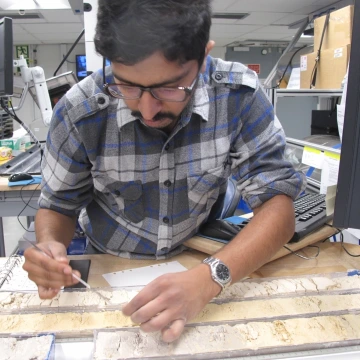Extreme monsoon variability could undermine Bay of Bengal’s role as a global food source

Dr. Aditya Peketi (left; Principal Scientist, National Institute of Oceanography, India) and Dr. Kaustubh Thirumalai (right; Associate Professor, University of Arizona) entering sedimentological data at one of the description tables in the core laboratory aboard the JOIDES Resolution drillship as part of Expedition 353, International Ocean Discovery Program, in the Bay of Bengal.
(Credit: Markus Fingerle & IODP)
A groundbreaking study led by scientists from the University of Arizona and Rutgers University warns that drastic changes in India’s summer monsoon may severely disrupt marine ecosystems in the Bay of Bengal, threatening a key source of food and livelihoods for millions.
Published in Nature Geoscience, the research brought together an international team of scientists from the University of Arizona, Rutgers, and institutions across India, China, and Europe. The team examined how fluctuations in the monsoon over the past 22,000 years have influenced marine productivity in the Bay of Bengal.
“By analyzing their chemistry and tracking the abundance of certain types that thrive in productive waters, we reconstructed long-term changes in rainfall, ocean temperatures and marine life in the Bay of Bengal,” said Dr. Kaustubh Thirumalai, an Assistant Professor in Geosciences at the U of A and lead author of the study. “Together, these chemical signals helped us understand how the monsoon and ocean conditions responded to global climate changes over the past 22,000 years.”
Despite covering less than 1% of the world’s ocean area, the Bay of Bengal provides nearly 8% of global fishery production. Its nutrient-rich coastal waters are vital to the densely populated communities along its shores, many of whom rely heavily on fisheries for food and income.
“Millions of people living along the Bay of Bengal rely on the sea for protein, particularly from fisheries,” said Dr. Yair Rosenthal, a Distinguished Professor at Rutgers University and an author of the study. “The productivity of these waters – the ability of the ocean to support plankton growth – is the foundation of the marine food web. If ocean productivity declines, it will powerfully affect the ecosystem, ultimately reducing fish stocks and threatening food security for coastal communities.”

To reconstruct past ocean conditions, Thirumalai analyzed fossilized shells of foraminifera, tiny single-celled marine organisms that record environmental data in their calcium carbonate shells.
The study found that both abnormally strong and weak monsoons throughout history caused major disruptions in ocean mixing, leading to a 50% reduction in food for marine life in the surface waters. This occurs because extreme monsoon conditions interfere with the vertical movement of nutrient-rich waters from the deep ocean to the surface, where plankton—the base of the food chain—flourish.
To reconstruct past ocean conditions, scientists analyzed fossilized shells of foraminifera, tiny single-celled marine organisms that record environmental data in their calcium carbonate shells. These microfossils were retrieved from seafloor sediments by scientists aboard the JOIDES Resolution, a National Science Foundation-funded research vessel operating under the International Ocean Discovery Program.
The researchers found that marine productivity declined sharply during periods like Heinrich Stadial 1 (a cold phase between 17,500 and 15,500 years ago) and the early Holocene (about 10,500 to 9,500 years ago), when monsoons were either unusually weak or strong. Monsoon rainfall directly affects river runoff into the Bay of Bengal, altering ocean salinity and circulation. When too much freshwater builds up at the surface, it prevents nutrient mixing. Conversely, weak monsoons reduce wind-driven mixing, also starving surface waters of nutrients.
“Both extremes threaten marine resource availability,” said Thirumalai.
By comparing ancient patterns with modern ocean data and climate model projections, researchers identified worrying similarities. Future scenarios suggest warmer surface waters and stronger freshwater runoff—conditions linked to past drops in marine productivity. Additionally, weaker future winds may fail to break through ocean stratification and restore nutrient cycling.
“Our study shows that major disruptions to ocean productivity in the Bay of Bengal occurred long before human civilization established itself on the Indian subcontinent,” said Thirumalai. “By looking deep into the past, we gain crucial insight into how the monsoon-ocean system responds to extreme shifts—insight we wouldn’t have from the human-made measurements alone. These paleoceanographic reconstructions give us a clearer lens to anticipate future risks and make informed choices to protect marine ecosystems and coastal communities.”
To learn more about Dr. Kaustubh Thirumalai and his research, click here.

